
About the CRN:
January 19, 2009
The Canadian Rivers Network (CRN) is a coalition of groups and organizations across Canada working together to:
- Inform Canadians about the value of our waters, rivers, lakes and streams.
- Advocate for the conservation of natural and cultural heritage values associated with Canadian waters, rivers lakes and streams.
- Advocate for the preservation of the ancient right of public navigation on Canadian waterways.
The CRN was formed in June of 2008 in direct response to an initiative of the federal government to amend the Navigable Waters Protection Act (NWPA) and eliminate navigation rights on thousands of waterways across Canada.
In media reports January 12 and 13, 2009, it became clear that this initiative to amend the NWPA and the Canadian Environmental Assessment Act is now part of the federal government’s economic recovery package.
OUR POSITION:
The federal government is acting radically by attempting to gut Canadian laws intended to protect the environment, under the guise of rescuing the economy.
The Harper government does not have a mandate to eliminate the public right of navigation on Canadian waterways, a common law right that predates confederation.
The Harper government does not have a mandate to gut the Canadian Environmental Assessment Act.
For more information on the Canadian Rivers Network, please email us or visit our website.
canrivers@sympatico.ca
www.ispeakforcanadianrivers.ca
Backgrounder:
January 19, 2009
The following detailed background information was prepared by the Canadian Rivers Network for use by organizations and individuals across Canada responding to the current efforts by the federal government to eliminate navigation rights on thousands of waterways through amendments to the Navigable Waters Protection Act.
This background does not paint a very pretty picture of what is occurring.
1) We have a federal government that is attempting to dismantle navigation rights and other environmental regulations in Canada under the pretext of rescuing the economy.
2) We have senior federal public servants who’s job it is to protect the long-standing public right of navigation in Canada, lobbying our government to take those rights away on thousands of waterways across the country.
NOTE: Direct quotes from listed sources are in blue. All of the source documents are available. Our notes are in black.
WHAT IS HAPPENING HERE:
SOURCE: Rod Northey, Fogler-Rubinoff, June 8, 2008, Parliament Hill
http://www.youtube.com/watch?v=Xzf9i8PETss&feature=related
What is happening right now with the Navigable Waters Protection Act is radical. The government is acting radically.
The right of navigation is not an 1882 invention. It is described by all of the courts in the English speaking world as an ancient right derived from Roman law. And most interestingly if you go south of the border or across the ocean where our law derives on the English side, you will find one further addition to the legal terminology…under English law navigation is not just a public right it is a matter of public trust. English law has a public trust doctrine. American law has a public trust doctrine. Their courts hold government to account for breaching public trust. So navigation is not just a mater of saying we have something we are trying to do, it is a matter of throwing back at the very governments that are trying to do something, a reminder that this kind of resource, our waters, are a matter of public trust that they are breaching.
What you want to say about the NWPA as you seek to reopen it is that you want to see a preamble an opening an introduction to that statue that describes the public trust in navigation across Canada. That will tell a story that is in keeping with the law from the south and Great Britain from Roman times that is in keeping with where you are today with the use of rives and where the government is in complete ignorance.
Navigable Waters Protection Act
SOURCE: http://www.tc.gc.ca/quebec/eng/NWP/menu.htm
The Navigable Waters Protection Act (NWPA), Chapter N-22, is a federal law designed to protect the public right of navigation in Canadian waters, as defined by the law, by prohibiting the building, placing or maintaining of any work whatsoever in, on, over, under, through or across any such navigable water, without the authorization of the Minister of Transport Canada.
The expression “navigable water” designates any body of water capable, in its natural state, of being navigated by any type of floating vessel for the purpose of transportation, recreation or commerce and includes a canal and any other body of water created or altered for the benefit of the public, as a result of the waterway assigned for public use.
The Navigable Waterways Protection Act (NWPA), Revised Statutes of Canada, 1985, is one of the oldest pieces of federal legislation. It first became law on May 17, 1882, and was originally intended to protect marine navigation routes by controlling the logging industry and the construction of bridges and dams.
It has undergone a number of changes over the years and its application no0w involves all works in, over, under through or across any navigable waterway in Canada.
Although the scope of the Act has been broadened over the years, its main objective is still to protect the public right to navigation. Today, the Act applies to many different types of projects undertaken on any of the navigable waterways and coastal zones of Canada.
HISTORY OF THE NWPA
May 17, 1882
Navigable Waters Protection Act becomes law in Canada. This was at a time in Canadian history when our waterways were our highways. Development was occurring on waters across the country and the Canadian government acted to ensure that the ancient right of public navigation would be protected for the future.
1883 The four named works were added:
- bridges
- booms
- Dams
- causeways
1886 wharves, docks, piers, and other structures were added
1985 most recent amendments to the act
JURISDICTIONAL HISTORY:
1882 to 1966 Department of Public Works
1966 to 1996 Transport Canada (Canadian Coast Guard)
1996 to 2004 Fisheries and Oceans (Canadian Coast Guard)
2004 jurisdiction transferred to Transport Canada (Marine Safety)
RECENT HISTORY:
June 2005, A Transport Canada Navigable Waters Protection officer says the following about the NWPA when speaking at the AGM of the Ocean Renewable Energy Group at Simon Fraser University:
“Navigable waters” includes any body of water which is capable, in its natural state, of being navigated by floating vessels of any description for the purpose of transportation, recreation or commerce, and includes a canal any other body of water created or altered for public use, as a result of the construction of any work.
“Navigable waters” also includes any waterway where the public right of navigation exists by dedication of the waterway for public purposes or by the public having acquired the right to navigate through long use.
The Canadian Environmental Assessment Act requires the federal government to ensure projects subject to approval under certain other acts undergo an assessment to determine the potential for adverse effects on the environment.
Projects requiring formal approval under the NWPA require environmental assessments.
Key Challenges:
- What is an appropriate mitigation strategy for impacts to navigation?
- Identification of appropriate locations for these ‘works and associated impact to users.
- Balance the need for economic development with the ‘Public Right of Navigation’.
January 2006, federal Conservatives form minority government.
July 2006 Transport Canada staff within the Navigable Waters Protection Program set up a project team and launch a multi-year initiative to gut the NWPA and eliminate navigation rights on thousands of Canadian waterways.
March 2007 A manager from the Navigable Waters Protection Program speaking at an NRCan regulatory efficiency workshop, illustrates very clearly that Transport Canada has changed its tune by describing the NWPA this way:
The Challenges:
The NWPA is a tool of choice for ‘hidden agendas’
- to mediate personal disputes
- to prevent development
- to achieve environmental objectives
This NWP program manager also stated that one of the problems with the NWPA was that clients and opponents had acquired increased knowledge about the act and its requirements related to developments on waterways.
April 2007 David Osbaldeston, the national manager for the Navigable Waters Protection program within Transport Canada, the senior federal public servant who’s job-one is to protect the navigation rights of Canadians, explained for the Transportation Association of Canada how he was going to eliminate navigation rights on waterways across the country, by exempting minor waters from the provisions of the NWPA, using the following definition for “minor waters”:
Proposed National Criteria for Minor Waters
Average Depth at Ordinary High Water < 0.60m
Width of Waterway at Ordinary High Water < 3.0m
Channel slope > 2%
Sinuosity ratio > 2
Natural obstacle frequency > 3
Sinuosity Ratio = ratio of the length of the centre line of the stream to length of a straight line connecting the same points along the channel
Natural Obstacle Frequency = number of natural obstructions (see definitions) along a stream length of 500m (250m upstream, 250m downstream)
It is important to note what Mr. Osbaldeston says here in very specifically describing exactly what waterways would be classified as “minor”, because less than one year later he would stand before the parliamentary committee for Transportation Infrastructure and Communities and assure the elected members of that committee that he had no specific definition in mind for “minor waters” under an amended NWPA.
January 2008 The federal Minister of Transport asks the parliamentary committee for transportation infrastructure and communities (TRAN) to look at the Navigable Waters Protection Act to determine if it could or should be amended.
February 2008 The TRAN committee then began a series of hearings and invited 70 “stakeholder groups” to make presentations on possible changes to the NWPA.
Of those 70 groups invited to speak to the TRAN committee, only one group (the Lake Ontario Waterkeepers) spoke about the value of the public right of navigation and the need to preserve that right.
All of the other of the hand-picked “stakeholders” invited to present to the TRAN committee argued for the elimination of navigation rights in Canada.
No one representing any of the following groups and interests were invited to present to the TRAN committee:
- No tourism groups
- No First Nations people
- No anglers or hunters
- No cottage or outdoor recreation groups or organizations
- No paddling organizations
The presentations to the TRAN committee were led by staff from within Transport Canada and included David Osbaldeston, the national manager for the Navigable Waters Protection Program.
Shirley Anne Scharf, a senior manager with Infrastructure Canada presenting the TRAN committee:
“The way it (the NWPA) is constructed right now—and I believe David Osbaldeston made this point—minor waters are such that I believe if you float a canoe in a body of water it is considered a navigable water. From that point of view, streamlining the act and excluding things of that nature would be very advantageous.”
David Osbaldeston, told the TRAN committee how he views his job as the senior federal public servant responsible for protecting and preserving the public right of navigation in Canada:
"As you can see, there's very little we deny or refuse. I think that's the main thing: if somebody has a need to put something in the water, over the water, under the water, or through the water, and has a valid need to do it, we'll try our utmost to get it done in a safe manner."
The minutes of the TRAN committee are available on-line. The meetings began in February 2008 and ended in early June of 2008.
http://cmte.parl.gc.ca/cmte/CommitteeList.aspx?Lang=1&PARLSES=392&JNT=0&SELID=e21_&COM=13202
From reading these minutes, it is clear that Transport Canada believes the NWPA as an obstacle to that development. It is also clear that the proposed changes to the NWPA would put virtually every river in Canada at risk.
June 2008 The TRAN committee, without consulting in any way with the people, groups and business sectors that would be impacted by the elimination of navigation right sin Canada, submits a report to the Minister of Transport recommending that the NWPA be amended.
September 2008 Proposed amendments to the NWPA are postponed by the fall federal election. In responding to an extensive public outcry over the potential elimination of navigation rights, the federal government insists that the TRAN committee hearings on the NWPA were simply a “preliminary” consultation and that the public will have a full and complete opportunity to comment on any proposed amendments through a public consultation process.
January 2009 The Harper government announces its intent to overhaul the NWPA to ensure that it does not get in the way of projects funded under its economic recovery infrastructure initiative.
John Baird, Minister of Transport, responsible for the Navigable Waters Protection Act:
SOURCE: National Post, January 12, 2009
"There's a lot we can do -- whether it's statutory, regulatory, processes -- that can speed up getting shovels in the ground," said John Baird, the Minister of Transport, Infrastructure and Communities, in an interview yesterday. "We have a lot of rules in place to stop bad things from happening, but little in place to facilitate good things."
Speaking directly to his plans to gut the NWPA and get it out of the way of the government’s infrastructure investment initiative, Minister Baird said:
"It's a piece of legislation brought in the 1800s with, frankly, little benefit but huge regulatory burden that can really slow things down," he said.
SOURCE: Globe and Mail January 13, 2009
John Baird, Minister of Transport, confirms the Harper government’s plan to do away with federal environmental regulations, including the NWPA.
"There's a real hodge-podge of environmental assessment requirements - of overlap and duplication," he told The Globe and Mail. "Many of them are just duplicating what's done at the provincial level."
Briefing Note:
January 19, 2009
Canadian Navigation Rights at Risk
The Harper government is poised to erase the historic right of navigation in Canada, a common law right that pre-dates confederation.
In public announcements published in the major media January 12 and 13, 2009, the Harper government stated its intent to eliminate the Navigable Waters Protection Act (NWPA) as part of its plan to inject billions of dollars into infrastructure programs across the country.
The Harper government says the NWPA is antiquated and they want it out of the way.
WHAT’S WRONG WITH THIS PICTURE?
1) The common law public right of navigation pre-dates confederation, in fact it dates back to Roman law and is entrenched in the legal systems of virtually all modern nations.
2) The public right to navigate waterways in Canada is and important part of our heritage and an integral part of the heritage of Canada’s Aboriginal peoples.
3) Navigation rights are one of the pillars of environmental protection on Canadian waterways. If you take away navigation rights, you put Canadian waters (our lakes and rivers and streams) at risk.
WHAT THE GOVERNMENT IS SAYING:
Here’s what Transport Minister John Baird says about the NWPA, the law in place to protect the right of Canadians to travel our waterways:
It’s a “…huge regulatory burden that can really slow things down," he said.
The government is also talking about “…overhauling the environmental assessment process, which addresses the effect of a project on the surrounding area.”
So the Harper government’s strategy in responding to Canada’s current economic challenge is to:
Save the economy by gutting the environment.
WHAT THE HARPER GOVERNMENT ISN’T TELLING YOU:
Their plan to erase navigation rights in Canada has nothing to do with the current economic situation. The plan to gut the NWPA is part of an overall strategy to remove environmental safeguards in Canadian law.
The current move to gut the NWPA dates is part of a multi-year strategy crafted within the Navigable Waters Protection Program of the Ministry of Transport dating back to the summer of 2006.
This strategy hit the public last May when it became known that the Parliamentary committee for transportation, infrastructure and communities was holding hearings on proposed changes to the NWPA, without consulting anyone with any interest in preserving the public right of navigation in Canada.
That parliamentary committee then rushed a report in June recommending the changes to the NWPA, the effect of which is to remove navigation rights from thousands of waterways across the country.
WHAT THE HARPER GOVERNMENT WANTS TO DO:
As earlier as April of 2007, the people responsible for protecting the right of all Canadians to navigate our waterways, had already crafted NWPA amendments that would eliminate protection of navigation rights on what its calls “minor waters” in Canada.
The historic test for navigable in Canada is, if you can paddle a canoe in it, it’s a navigable waterway. There is probably not a more appropriate test in Canadian legal tradition than this “float a canoe” test in the NWPA. It is distinctly Canadian. It’s part of our heritage.
Here’s what Transport Canada and the Harper government want to do to that Canadian tradition, a proposed definition for “minor waters” dating to 2007:
Minor Waterways Criteria – Proposed National Criteria
- less than 60 cm depth at high water mark
- less than 3 m wide at high water mark
- channel slope greater than 2 percent
- sinuosity* (bends in the river) greater than 2
- natural obstacle frequency* greater than 3
Sinuosity Ratio = ratio of the length of the centreline of the stream to
length of a straight line connecting the same points along the channel
Natural Obstacle Frequency = number of natural obstructions (see
definitions) along a stream length of 500m (250m upstream, 250m downstream)
WHAT YOU CAN DO:
Voice your opposition to the Harper government’s to plan to save the economy by gutting the environment.
Tell your municipal, provincial/territorial and federal representatives that you don’t want the historic right of navigation diminished in Canada. You want it protected for the future.
Visit our website for information on ways that you and your organization can help.
www.ispeakforcanadianrivers.net


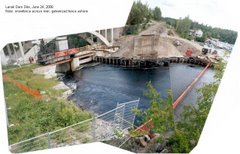

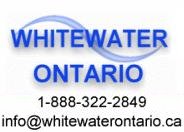
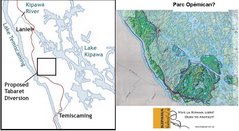

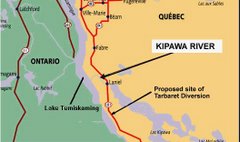

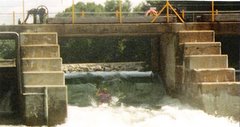







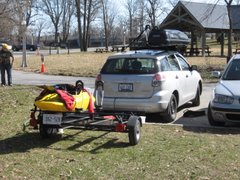

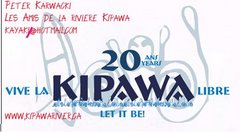
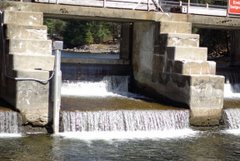


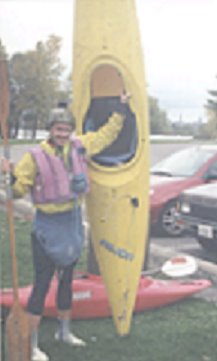



No comments:
Post a Comment